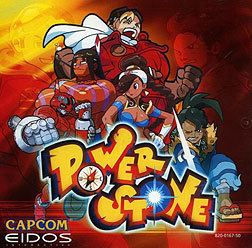9.2 /10 1 Votes
4.6/5 Emuparadise Genre(s) Arena Fighting Initial release date 13 February 1999 Designer Hideaki Itsuno Publishers Capcom, Eidos Interactive | 4.6/5 eBay Composer(s) Tetsuya Shibata Arcade system Sega NAOMI Developer Capcom Mode Single-player video game | |||||||||||||||||||||||||||||||||
 | ||||||||||||||||||||||||||||||||||
Platforms Dreamcast, Arcade game, PlayStation Portable Similar Capcom games, Fighting games | ||||||||||||||||||||||||||||||||||
Power stone dreamcast gameplay
Power Stone is a fully 3D arena fighting game series made by Capcom. Power Stone was initially released on the Sega NAOMI hardware and later ported to the Dreamcast. In 2006, Capcom ported the entire series, known as Power Stone Collection, to the PlayStation Portable with a few enhancements: most notably, the PSP version of the original Power Stone included the four new characters introduced in Power Stone 2. An anime TV series based on the game ran in 1999 from April 3 to September 25.
Contents
- Power stone dreamcast gameplay
- omg it s like power stone 2016 this game is dope af last fight randomplays
- Gameplay
- Plot
- Characters
- Reception
- Legacy
- References

The original Power Stone featured ten characters.
omg it s like power stone 2016 this game is dope af last fight randomplays
Gameplay

Gameplay involves selecting a character and then proceeding to battle the other characters, one at a time, in various locales. The three-dimensional fighting includes the ability to use special attacks as well as to pick up and fight with such objects as tables, chairs, rocks and bombs. During battle, "Power Stones", resembling gems of different colors, appear in the arena. If a character collects three Power Stones, he/she transforms into a more powerful version of himself/herself. He/she will then be able to use one of two super special attacks: generally a massive long-range power attack and a grab or close-range move. The powered-up mode only lasts until the power bar is fully drained, during which the special attack can be executed (which completely depletes the power bar) or other, lesser special moves can be executed (which only use a small portion of power). Each match continues until the life bar of one of the two characters fighting is depleted.
Plot

Set in the 19th century, strong believers of legends, myths and superstition search for fame, fortune and glory. One legend above all is sought after by many, a treasure which can make any dream come true. Believers from all over the world set out to search for this treasure, and are forced to fight against one another in pursuit of the legendary Power Stone.
Characters
There are 10 characters in the original Power Stone.
Reception
The Dreamcast version of Power Stone received "favorable" reviews according to video game review aggregator GameRankings. However, Power Stone Collection received "average" reviews according to video game review aggregator Metacritic. In Japan, Famitsu gave the former console version a score of 34 out of 40. In Europe, Computer and Video Games gave it a full 5-star rating, stating that "it's fantastic."
Legacy
A sequel was released in 2000 called Power Stone 2, which featured the original cast (minus the hidden characters Kraken and Valgas) as well as several new characters.
The sequel features the same three dimensional combat system, but now allows up to four players to play simultaneously. There are new maps, some of which contain multiple areas and moving sections. The sequel also features an entirely new arsenal of weapons, from futuristic handguns to gigantic mallets, and magic wands to vehicles. Players can collect these items in a special "Adventure" mode; they can then be traded at a special "Item Shop", or combined together to form new items.
A remake of the first two games was released for the PSP in 2006 under the name 'Power Stone Collection'. This collection contains slightly updated versions of both games (Dreamcast versions) on one UMD.
A lone Power Stone Manga from KC BomBom Comic was issued on 15 March 1999. The anime is mostly based on this and the previewed graphics can be found in Dreamcast official site.
